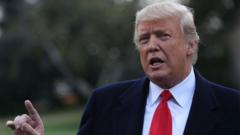How Does the Supreme Court's Birthright Citizenship Ruling Expand Trump's Power?

The Supreme Court's Landmark Decision: Impact on Executive Power and Birthright Citizenship
In a pivotal moment for the American political landscape, the Supreme Court recently issued a ruling that could reshape the balance of power between the executive branch and the judiciary. This decision, which has drawn reactions from various quarters, marks a significant victory for former President Donald Trump, paving the way for future presidents to assert their authority without the looming threat of immediate judicial intervention. With implications that stretch beyond Trump’s controversial birthright citizenship order, this ruling challenges the power of lower courts and sets the stage for extensive legal battles ahead.
Understanding the Supreme Court's Ruling
On a Friday that many viewed as crucial for the Trump administration, the Supreme Court ruled in favor of allowing the executive order concerning birthright citizenship to go into effect. This ruling signifies a notable shift in how lower courts can influence executive actions. Previously, federal judges could issue nationwide injunctions that effectively halted the implementation of executive orders, creating a major hurdle for presidential policies.
The Birthright Citizenship Controversy
The concept of birthright citizenship, established under the 14th Amendment, grants automatic citizenship to anyone born on U.S. soil. Trump's executive order seeks to challenge this long-standing principle, aiming to restrict citizenship for children of undocumented immigrants. The Supreme Court's ruling allows this executive order to move forward, albeit with caveats that involve lower courts assessing the implications for individual plaintiffs.
Key Takeaways from the Decision
- Executive Authority Strengthened: The ruling enhances the power of the executive branch, enabling presidents to enact policies more freely without facing immediate nationwide blocks from lower courts.
- Potential for Legal Battles: While the ruling allows the executive order to take effect, it leaves the door open for states and individuals to challenge it in lower courts, indicating that legal battles are far from over.
- Financial and Administrative Concerns: The Supreme Court acknowledged that states may face financial injuries and administrative burdens stemming from the executive order, which could necessitate further legal scrutiny.
The Political Reactions
Reactions to the Supreme Court's ruling have been mixed. Trump hailed the decision as a "monumental victory," emphasizing its potential to strengthen the rule of law and the separation of powers. He described the birthright citizenship policy as a “birthright citizenship hoax” that needed to be addressed to combat perceived abuses of the immigration system.
Conversely, critics argue that this ruling could lead to significant humanitarian issues and a potential erosion of civil rights. The Democratic Party and various advocacy groups have voiced concerns that revoking birthright citizenship could undermine the foundation of American values and lead to an increase in statelessness among children born in the U.S.
The Broader Implications for Executive Power
The Supreme Court's decision has far-reaching consequences, not only for the birthright citizenship order but for executive actions across various policy areas. The ruling signifies a shift in judicial philosophy regarding the scope of executive power and the authority of lower courts.
Impacts on Future Presidential Actions
Historically, both Democratic and Republican presidents have faced challenges from lower courts regarding their executive actions. Trump's administration has been no exception, with numerous initiatives blocked by federal judges. In fact, from his inauguration to April 29, the Congressional Research Service reported 25 instances where lower courts intervened to halt presidential actions, including:
- Restrictions on foreign assistance
- Changes to diversity programs
- Limitations on terminating government employees
- Changes to immigration reforms
- Suspension of modifications to election processes
With the Supreme Court's ruling, the Trump administration is now better positioned to pursue its agenda without the fear of immediate judicial intervention. This could embolden future presidents, regardless of party affiliation, to act more decisively on their policy priorities.
The Role of Lower Courts Moving Forward
While the Supreme Court has curtailed the power of lower courts to issue sweeping nationwide injunctions, it has also emphasized the need for these courts to act expeditiously and fairly in assessing individual cases. This delicate balance suggests that lower courts will still play a crucial role in determining the legality of executive actions, albeit within a more constrained framework.
Justice Amy Coney Barrett, writing for the majority, made it clear that lower courts retain the responsibility of evaluating whether a narrower injunction is necessary. This means that while the broader power of the executive branch has been reinforced, the checks and balances inherent in the American legal system remain intact to some extent.
Looking Ahead: The Future of Immigration Policy
Trump's birthright citizenship order is just one of many immigration-related policies that could be affected by this ruling. The Supreme Court has opened the door for further legal challenges, and state governments, particularly those run by Democrats, are unlikely to comply readily with the administration's directives regarding birth certificates and citizenship documentation.
As the Biden administration navigates its own legal challenges, it remains to be seen how this ruling will influence its approach to immigration reform and other policy areas. The precedent set by this decision may lead to a more combative relationship between the executive branch and the judiciary in the years to come.
Conclusion
The Supreme Court's ruling serves as a landmark moment in the ongoing debate over executive power and immigration policy in the United States. By reinforcing the authority of the executive branch while simultaneously allowing for challenges in lower courts, the decision creates a complex legal landscape for future administrations. As the implications of this ruling unfold, it will be critical for both lawmakers and citizens to engage in discussions about the balance of power and the principles that underpin American democracy.
How will the Supreme Court's decision reshape the landscape of executive power and immigration policy in America? The future remains uncertain, but one thing is clear: the legal battles are far from over.
FAQs
What does the Supreme Court's ruling mean for birthright citizenship?
The ruling allows Trump's executive order to end birthright citizenship to go into effect, while permitting lower courts to evaluate individual challenges to the order. This may lead to significant legal disputes moving forward.
How does this ruling affect the balance of power between branches of government?
The decision strengthens executive power by limiting the ability of lower courts to issue nationwide injunctions, allowing presidents to act more decisively on their policies while maintaining some checks through the judiciary.
What are the potential consequences of ending birthright citizenship?
Ending birthright citizenship could lead to significant legal and humanitarian issues, including statelessness among children born in the U.S. and increased challenges in immigration policy.
As the legal landscape evolves, how do you think this ruling will impact future presidential policies? #SupremeCourt #ExecutivePower #BirthrightCitizenship
Published: 2025-06-27 16:51:03 | Category: wales



